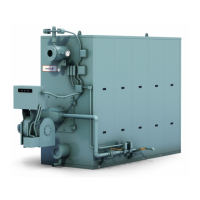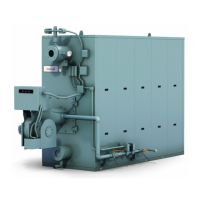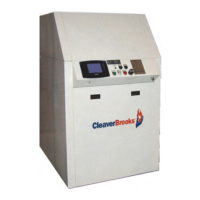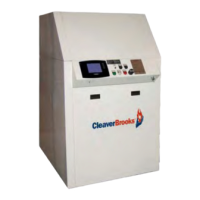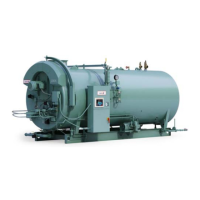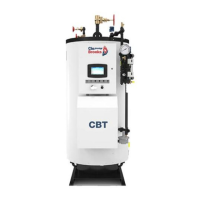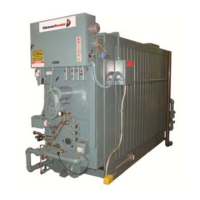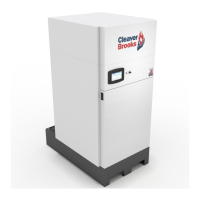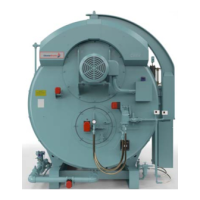STARTING AND OPERATING INSTRUCTIONS Chapter 5
750-177 5-9
NOTE: The linkages have been factory-set
and tested, although they may require fine
adjustment for the specific application. If
the linkage is not in place, or if the setting
has been lost, install the linkage in
accordance with Figure 5-9.
2. Place the burner switch to the OFF position.
3. Place the Manual/Auto mode switch to the MANUAL
position.
4. Place the manual flame control potentiometer in the
CLOSED (low-fire) position.
5. Check the presetting of the air shutters. (If the linkage is
loose and no pre-settings are available, start with the
shutter in the full open position).
STARTUP. Proceed with startup of the natural gas-fired sys-
tem as follows:
1. Close the manual shutoff valves on the burner gas train.
2. Turn on electrical power for the burner, boiler, and
related components.
3. Place the upstream manual gas valve in the on position,
allowing natural gas to enter the gas train. (furthest from
the burner). Reset Low Gas Pressure Switch (if
applicable).
4. Verify that the gas metering valve is nearly closed.
5. Turn the burner switch on. This will start the blower
motor and initiate the prepurge sequence.
6. When the prepurge sequence ends, the pilot valve will
open. The pilot flame should be visible from the viewing
window.
7. When the pilot is established, the flame safeguard will
energize the main gas valve (this is accompanied by fuel
valve activity and illumination of the FUEL VALVE
light). The main gas valve should be visually checked by
observing the stem move from the CLOSED to the
OPEN position.
NOTE: For initial boiler startup, the
downstream manual gas shutoff valve
should be in the closed position to ensure
proper operation of the automatic gas
valves. This valve can then be slowly
opened when the pilot is established and
proven.
8. After the main flame has been established, the gas
manifold pressure entering the burner should be read
(using the pressure tap between the butterfly valve and
the blast tube) to determine an initial estimate of the gas
input rate and compare to Figure 5-10. This will provide
an approximation of the burner input. Obtain a stable
operating point by adjusting the butterfly valve to the
pressure indicated in Figure 5-10, and select the
temporary firing rate. This rate for startup is not critical,
but merely an acceptable starting point to begin the high
fire adjustment procedures.
9. After a few seconds, the 0
2
analyzer should have an
accurate reading of the 0
2
present in the flue gas. Table 5-
1 shows the acceptable 0
2
range for the gas burner.
Normally, 0
2
levels are set between 3 and 5 percent at
low fire, depending on the application and burner size
(see the burner specification plate for the minimum firing
rate).
10. Operate the boiler at low fire until it is up to operating
pressure (steam) or temperature (hot water). Then
increase the fuel input to the boiler by turning the manual
flame control potentiometer towards OPEN in small
increments. This will cause the butterfly valve to open,
allowing more gas into the burner. While increasing the
input, observe that the 0
2
levels remain within the range
listed in Table 5-1. Adjust the gas pressure regulator, as
necessary, to correct this situation. Continue to do this
until the burner reaches high fire (the potentiometer is at
the open position).
11. Adjust the high fire gas input to match the maximum
rating. At high fire, the butterfly valve should be near the
full open position. Adjust gas pressure to obtain the
correct fuel input. (Maximum pressure is specified on the
burner specification plate.)
If a dedicated gas meter is available, the following for-
mula may be used to check fuel flow. Conduct this mea-
surement while operating at a constant rate.
Note: Some meters may require 6.0 IN. H
2
0
correction to Pgas. Consult meter
calibration data.
Where:
HHV = The higher heating value of natural gas (1000
Btu/ft
3
). Contact your local gas company for an exact
measurement.
P
atm
= Atmospheric pressure in inches of mercury.
P
gas
= Gas pressure ahead of the volumetric flow meter
in inches of mercury.
T
gas
= Gas temperature at the volumetric flow meter in
°F.
RATE = Natural gas rate taken with the volumetric flow
meter in ft
3
/second.
S = Seconds.
12. Adjust the high fire excess air rate using the high-fire
shutter adjustment (see Figure 5-9 for location).
Gas Input = (HHV) x
Patm + Pgas
29.92
xxx
=
520
Tgas + 460
3600
hr
RATE
ft
3
s
s
Btu
hr

